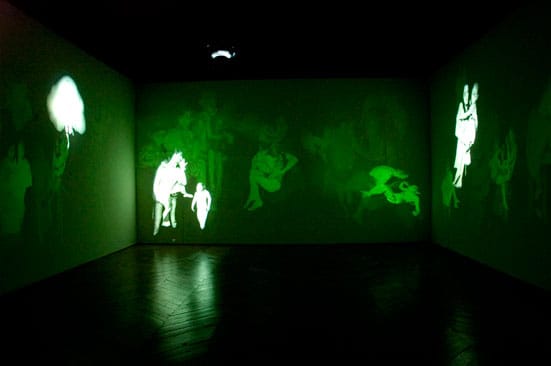11th April 2008 — 22nd May 2008
Bloodshed and calamity provoke grim fascination. Within the Christian church they are called upon to express a range of emotions, from terror to compassion. Fearsome frescoes of souls burning in hell and a quietly suffering Christ can be found under the same basilica roof as cluttered shrines of ex-voto, paintings of sickbeds with angels hovering, house fires, people falling from ladders and being trampled by horses, with profuse thanks to the saints in spidery handwriting. Later, ‘before-and-after’ paste jobs took the place of paint: disaster scenes clipped from the local paper alongside snaps of the victims recuperating in hospital. In a word, deliverance.
Collishaw has turned the meaning around, though. He sees the press and TV news crews exacerbating people’s plight in traumatic situations. He speaks of victims “…fleeing one explosive situation and running into the barrel of the media.” Using actors, he has set up a series of tableaux. Men and women emerge from smoky darkness cradling children in their arms, dusty and streaked with blood. The Adults are blank with shock and the kids, clad only in underwear, small and vulnerable.
The space is long and narrow, stygian at first - more like a section of underpass than a gallery. Flashgun-like bursts regularly puncture the darkness. Three revolving projectors are suspended from the ceiling,
firing the tableaux onto the walls, which are coated with luminous paint. The images glow brightly then slowly fade, mouldy-green collages of woe building up and disappearing around the room in a continuing cycle. The pictures are based on the Belsan massacre. Everyone remembers the real events, that caused revulsion, primarily for the outrage itself, but also for the overzealous coverage by the news gatherers, who captured every grisly detail. It is as a result of this incident that the BBC now enforces a time delay on live news reports so any scene considered too upsetting can be cut. The Russian public was incensed for another reason, believing that the State media had suppressed important details relating to the massacre.
One of the little girls in the piece bears a resemblance to Kim Phuc, the Vietnamese napalm victim who became a horrific icon to the cruelty of the Vietnam war in 1972, and did so much to bring home the gut-wrenching madness of what was going on there. The image harks back to another era of photojournalism that is disappearing. Governments are much more careful about what information leaks out from theatres of war. Embarrassing atrocities are only revealed when the perpetrator’s happy snaps get into the wrong hands. Otherwise they are the handiwork of execution squads, sent to the news agencies copyright-free to scare us, the public out of its wits. The pictures that command the real bucks are of celebrities making fools of themselves.
Nick Ut, who won a Pulitzer for that infamous picture in Vietnam is still working for Associated Press, but now as a Tinsel Town paparazzo. The last time he came up on the news radar was when he got a shot of Ms. Hilton sobbing in a car on her way to jail. In London we get three free newspapers a day but we’ve never before received such sketchy knowledge about the world. The little hard news we do get is wedged between restaurant pages, absurd dating advice lurid ‘human interest’ stories, and frighteningly reactionary rants of the ‘political correctness gone mad’ ilk on the letters pages. Ironically, if you squinted, grab-shots of an underdressed, bewildered, nodding-out Winehouse, and a dishevelled, sobbing Britney would fit into the action on these walls. We still need our hit of ‘suffering-lite’, and the shallow tales and upskirt shots of the glitterati provide it for us.
Hanging in the corridor outside the main gallery are exquisitely made, silver-speckled daguerrotypes. Grisly souvenirs of atrocity at £1,500 a pop. Collishaw himself is now clutching the gun-barrel. Only the spectators in this exhibition retain the moral high ground. But this make-believe melodrama is cunningly crafted. The daguerrotypes are anachronisms, the projectors, the sophisticated sort designed for lightshows. As the pulsating scenario discovates around the walls the spectators are caught red handed, swivelling on their heels, shamelessly rubbernecking the carnage.
Phil Harris
Spring Projects
London NW5 3BH
http://www.springprojects.co.uk
Open
Tuesday & Wednesday, 10am-5pm
Thursday & Friday, 12-7pm
Saturday, 11am-4pm

Mat Collishaw ‘Deliverance’ Still 2008